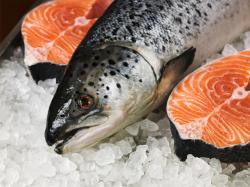Omega-3 May Cut Risk Of Artery Disease, Heart Attacks For Patients With Stents
June 3, 2011 | 3 min to read

DALLAS — Omega-3 fatty acids, combined with two blood-thinning drugs, significantly changed the blood-clotting process and may reduce the risk of heart attacks in patients with stents in their heart arteries, according to research reported in Arteriosclerosis, Thrombosis and Vascular Biology: Journal of the American Heart Association.
Foods rich in omega-3, such as salmon and other oily fish, have been previously shown in other studies to reduce the risk of heart problems in people with coronary artery disease. In this study, the participants were given the pill form of omega-3 (1,000 milligrams n-3 PUFA daily) and were encouraged to increase their consumption of oily fish.
This study sought to determine what effects omega-3 might add to those of aspirin and clopidogrel.
"There are no other studies on omega-3 effects in patients who were already being treated with optimal medical therapy after stent placement," said Grzegorz Gajos, M.D., Ph.D., lead author and assistant professor of cardiology at Jagiellonian University in Krakow, Poland. "This was a proof of concept study. We were looking for any effect and what it might be."
The Omega-PCI Study – a double-blind, placebo-controlled trial – found patients who received the omega-3 pills with aspirin and clopidogrel had blood clots more susceptible to destruction than patients who received only the two blood thinners. The research team particularly targeted the protein fibrin and the interlaced structure it forms in coagulated blood.
Gajos and colleagues examined findings from 54 patients (41 men, 13 women, average age 62.8 years) who participated in the trial conducted at John Paul II Hospital in Krakow.
This study evaluated the effects of omega-3 in patients with stable coronary artery disease who had their clogged heart arteries opened by a catheter procedure and a stent successfully inserted to help keep the vessels opened. Previously, the researchers had reported that adding omega-3 to the clopidogrel antiplatelet drug after stenting significantly lowered the platelet response in clotting.
For this study researchers randomly selected 24 patients as controls and 30 for treatment before their heart procedures. Both groups received the same daily doses of aspirin and clopidogrel for four weeks after stenting. The treatment group received 1,000 milligrams of omega-3 daily and the controls received a placebo each day.
The study showed that, in comparison with the control group, the omega-3 treated patients:
•Produced less of a clotting factor called thrombin.
•Formed clots with an altered and favorable structure — including larger pores — that made them easier to disrupt. Therefore the clot-destruction time was 14.3 percent shorter. This might prove important in protecting patients, especially those with drug-eluting stents who occasionally develop potentially fatal late clots.
•Had less oxidative stress.
•Showed no significant changes in fibrinogen and clotting factor (II, XIII) levels. Fibrinogen is a protein produced by the liver. This protein helps stop bleeding by helping the formation of blood clots. Fibrinogen is converted by thrombin into fibrin during blood coagulation. The implication of this finding suggests that changes in the three biomolecules had no role in reducing the treatment group's thrombin generation and altering the structure of blood clots that formed, Gajos said.
"Our study suggests that combined moderate anti-thrombotic and anti-platelet actions of omega-3, when added to those of other treatments, may improve outcomes for coronary artery disease patients," Gajos said.
Study participants experienced only mild adverse side effects and the number of events did not vary significantly between the two groups. There were not enough participants to assess clinical benefit from the changes in the clotting process.
Another limitation of the study was the inability to extrapolate the findings to healthy individuals, those with a high coronary artery disease risk, and those not taking aspirin and/or clopidogrel.
"We are planning a larger follow-up study that will include outcomes and continue indefinitely," Gajos said.
Co-authors are Jaroslaw Zalewski, M.D., Ph.D.; Pawel Rostoff, M.D.; Jadwiga Nessler, M.D., Ph.D.; Wieslawa Piwowarska, M.D., Ph.D.; and Anetta Undas, M.D., Ph.D.
Author disclosures and funding are on the manuscript.
Statements and conclusions of study authors published in American Heart Association scientific journals are solely those of the study authors and do not necessarily reflect the association's policy or position. The association makes no representation or guarantee as to their accuracy or reliability. The association receives funding primarily from individuals; foundations and corporations (including pharmaceutical, device manufacturers and other companies) also make donations and fund specific association programs and events. The association has strict policies to prevent these relationships from influencing the science content. Revenues from pharmaceutical and device corporations are available at www.americanheart.org/corporatefunding.
NR11 – 1080 (ATVB/Gajos)
Additional resources:
•Downloadable stock footage, animation and our image gallery are located at www.heart.org/news under Multimedia.
•Coronary Stent Animation
•What is a stent?
•Fish and Omega-3 Fatty Acids
CONTACT:
Karen Astle: (214) 706-1392
Bridgette McNeill: (214) 706-1135
Julie Del Barto (broadcast): (214) 706-1330
Source: American Heart Association
